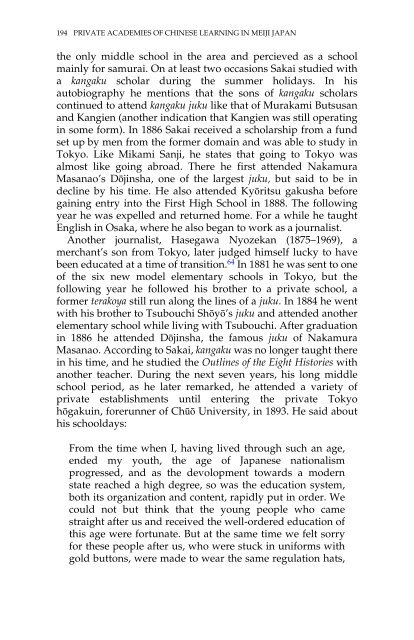Private Academies of Chinese Learning in Meiji Japan: The Decline ...
Private Academies of Chinese Learning in Meiji Japan: The Decline ...
Private Academies of Chinese Learning in Meiji Japan: The Decline ...
You also want an ePaper? Increase the reach of your titles
YUMPU automatically turns print PDFs into web optimized ePapers that Google loves.
194 PRIVATE ACADEMIES OF CHINESE LEARNING IN MEIJI JAPANthe only middle school <strong>in</strong> the area and percieved as a schoolma<strong>in</strong>ly for samurai. On at least two occasions Sakai studied witha kangaku scholar dur<strong>in</strong>g the summer holidays. In hisautobiography he mentions that the sons <strong>of</strong> kangaku scholarscont<strong>in</strong>ued to attend kangaku juku like that <strong>of</strong> Murakami Butsusanand Kangien (another <strong>in</strong>dication that Kangien was still operat<strong>in</strong>g<strong>in</strong> some form). In 1886 Sakai received a scholarship from a fundset up by men from the former doma<strong>in</strong> and was able to study <strong>in</strong>Tokyo. Like Mikami Sanji, he states that go<strong>in</strong>g to Tokyo wasalmost like go<strong>in</strong>g abroad. <strong>The</strong>re he first attended NakamuraMasanao’s Dōj<strong>in</strong>sha, one <strong>of</strong> the largest juku, but said to be <strong>in</strong>decl<strong>in</strong>e by his time. He also attended Kyōritsu gakusha beforega<strong>in</strong><strong>in</strong>g entry <strong>in</strong>to the First High School <strong>in</strong> 1888. <strong>The</strong> follow<strong>in</strong>gyear he was expelled and returned home. For a while he taughtEnglish <strong>in</strong> Osaka, where he also began to work as a journalist.Another journalist, Hasegawa Nyozekan (1875–1969), amerchant’s son from Tokyo, later judged himself lucky to havebeen educated at a time <strong>of</strong> transition. 64 In 1881 he was sent to one<strong>of</strong> the six new model elementary schools <strong>in</strong> Tokyo, but thefollow<strong>in</strong>g year he followed his brother to a private school, aformer terakoya still run along the l<strong>in</strong>es <strong>of</strong> a juku. In 1884 he wentwith his brother to Tsubouchi Shōyō’s juku and attended anotherelementary school while liv<strong>in</strong>g with Tsubouchi. After graduation<strong>in</strong> 1886 he attended Dōj<strong>in</strong>sha, the famous juku <strong>of</strong> NakamuraMasanao. Accord<strong>in</strong>g to Sakai, kangaku was no longer taught there<strong>in</strong> his time, and he studied the Outl<strong>in</strong>es <strong>of</strong> the Eight Histories withanother teacher. Dur<strong>in</strong>g the next seven years, his long middleschool period, as he later remarked, he attended a variety <strong>of</strong>private establishments until enter<strong>in</strong>g the private Tokyohōgaku<strong>in</strong>, forerunner <strong>of</strong> Chūō University, <strong>in</strong> 1893. He said abouthis schooldays:From the time when I, hav<strong>in</strong>g lived through such an age,ended my youth, the age <strong>of</strong> <strong>Japan</strong>ese nationalismprogressed, and as the devolopment towards a modernstate reached a high degree, so was the education system,both its organization and content, rapidly put <strong>in</strong> order. Wecould not but th<strong>in</strong>k that the young people who camestraight after us and received the well-ordered education <strong>of</strong>this age were fortunate. But at the same time we felt sorryfor these people after us, who were stuck <strong>in</strong> uniforms withgold buttons, were made to wear the same regulation hats,













